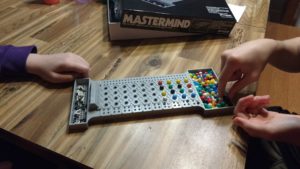This week we’ll cover a board game that is tons of fun to play, but takes a lot of time. This is a good rainy day family fun day game, so if you’ve never heard of it, read on.
The Settlers of Catan game includes a board that is dynamic. The pieces that make up the board can be put together like a puzzle, but they’re mixable so you can move where each little land plot can be placed. The instructions include a recommended default layout for beginners, and it is highly recommended to follow it, since it gives a good balanced layout of lands around the board.
First you build the outer border (which is supposed to fit together the same way every time, with number tabs/slots that connect.) Then you place hexagonal land pieces inside like a honey comb. Once the whole board is laid out, you place numbered tokens on each land.
A “robber” piece goes on the desert land.
Each player picks a color and takes 5 settlements, 4 cities, and 15 roads. Each player places two settlements and two roads on the board to start. A settlement goes on the corner of one of the hexagonal shaped land pieces, and a road runs long the edge of the hexagonal land piece. Each land that a settlement touches allows that settlement to potentially obtain whatever resource it can produce in a round.
A round begins by rolling the two six sided dice “for production.” The roll applies to all players, not just the person rolling the dice. Whatever number is rolled determines which lands may produce resources that round (based on those numbered tokens that got placed on each land.) Any settlement on the corner of land that produces that round gets a resource card for the resource that particular land produces. Rolling a 7 is special, and we’ll get to it in a bit.
After rolling for resources, the player that rolled the dice may trade resources. There are two kinds of trade. Domestic trade allows the player that rolled the dice to trade with the other players on negotiation terms. The other kind of trade is maritime trade, and allows for “trading” resources without trading with other players. The normal (and worst) maritime trade is a 4:1 ratio. A player may turn in any 4 of one resource card in exchange for one other resource card. If the player has a settlement on the outer edge of the island next to a harbor, the harbor allows for maritime trade, which has more favorable ratios.
Once trading is done, if any, the player that rolled the dice may build. Building costs are dependent upon “building cost cards.” Refer to the card and spend the appropriate number of resources to build a new settlement or road, or to upgrade a settlement to a city. You can’t build a settlement on an unoccupied intersection if any of the adjacent intersections contains a settlement or a city. This means you can’t ever have more than three settlements/cities on one hexagonal land piece. You also have to build the new settlements along one of your existing roads. You can also spend resources to obtain a “knight card” or a “victory point” card.
A special “longest road” and “largest army” card are set aside until someone earns them. To earn the “longest road” card, you need to be the first to build a continuous road of at least 5 individual road pieces. After that, it can be stolen by someone else if they build a road that is longer than yours. The “largest army” card is earned by becoming the first player to earn three knight cards. Anyone earning more knight cards than you will take it, later. Each of these cards is worth two victory points for the holder of the card.
To put a damper on things, there is a robber in the desert. Any time someone rolls a “seven” several things happen. First everyone with seven or more cards must discard half of them (odd numbers rounded down, first.) Next, the player that rolled the seven must move the robber to the number token of a terrain hex, or back to the desert if it’s already on a terrain hex that isn’t desert. Finally, that player is allowed to steal one resource card from one player with a settlement next to that resource hex.
If a player plays a knight card on their turn, they move the robber as if a seven were rolled and attempt to steal a player resource card. The player being robbed places his cards face down and the robbing player picks one at random. If the robbed player has no cards, nothing is stolen.
The first player to reach ten victory points wins. Points aren’t awarded each turn, they are counted based on what the player holds.
- Settlement = 1 VP each
- City = 2 VP each
- Longest Road card = 2 VP
- Largest Army card = 2VP
- Victory Point card = 1VP
This game is complex, and play time can reach or exceed the time it would take to play a decent game of Monopoly (for comparison.) It does help develop strategic thinking, though, and does so with an excess of fun.
I’m sorry this one ran a bit long, but it is what it is. Thanks for reading!
The Game is available at Amazon, and probably other retail outlets.
